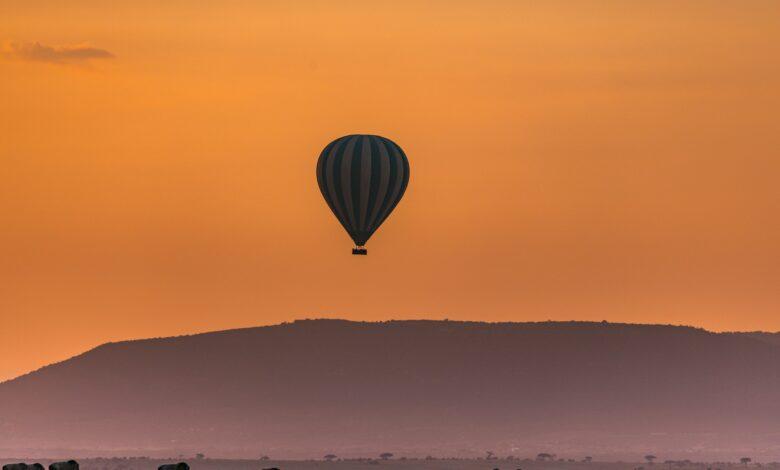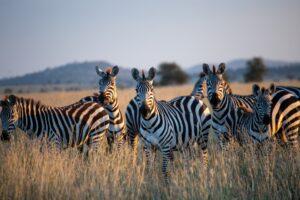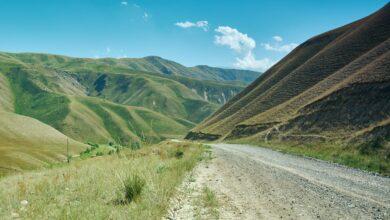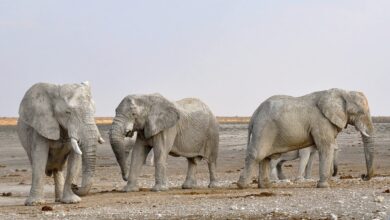🌍 An African Adventure: Safari in Serengeti National Park 🦁
Discover the Serengeti's Natural Wonders and Wildlife Splendors

Introduction
The Serengeti National Park, a land of boundless natural beauty, teeming with wildlife, is every adventurer’s dream destination. Located in the heart of East Africa, this iconic park is renowned for its breathtaking landscapes, rich biodiversity, and unforgettable safari experiences. In this article, we will take you on an African adventure, where the sprawling plains of the Serengeti become the backdrop for an awe-inspiring safari.
As the golden sunsets paint the vast savannah with hues of orange and red, and the distant roars of lions echo through the wilderness, you’ll embark on a journey that promises to be both exhilarating and transformative. Whether you’re an experienced traveler or a novice explorer, the Serengeti offers something extraordinary for everyone. Join us as we delve into the enchanting world of this world-famous national park and explore the wonders it has to offer.
Planning Your Serengeti Safari
Choosing the Right Time to Visit the Serengeti for Your Safari
Embarking on a Serengeti safari is a dream come true for many wildlife enthusiasts. To make the most of this once-in-a-lifetime experience, you’ll want to carefully plan your trip, and one of the crucial aspects of this planning is choosing the right time to visit. The Serengeti National Park in Tanzania offers unique wildlife viewing opportunities year-round, but your experience can vary significantly depending on the season you select.
The Serengeti’s renowned Great Migration is a breathtaking spectacle that occurs in different parts of the park throughout the year. Typically, it follows a circular pattern, and depending on the month, you can witness vast herds of wildebeest and zebras crossing the plains or calving season in the south. To maximize your chances of witnessing this awe-inspiring event, you should time your visit accordingly.
The dry season, from late June to October, is generally considered the best time for game viewing. The weather is dry, the grass is shorter, and animals gather around water sources, making it easier to spot the Big Five (lion, leopard, elephant, buffalo, and rhinoceros). However, this is also the peak tourist season, so booking accommodations well in advance is essential.
If you prefer fewer crowds and are interested in bird watching, the green season, which is the wet season from November to May, might be more appealing. The landscape is lush and teeming with birdlife, and you can enjoy lower rates for accommodations.
Booking Accommodations in the Serengeti
Once you’ve decided when to visit the Serengeti, the next vital step in planning your safari is booking accommodations. The park offers a variety of lodging options to suit different preferences and budgets. From luxurious tented camps to budget-friendly lodges, there’s something for everyone.
Luxury tented camps provide a unique blend of comfort and immersion in the natural surroundings. These accommodations offer spacious tents with en-suite bathrooms, fine dining, and personalized service. They allow you to experience the Serengeti’s wildlife while enjoying the comforts of a five-star hotel.
For those seeking a more budget-friendly option, there are mid-range lodges and camps that still provide comfortable amenities and an authentic safari experience. These options are particularly popular among travelers who want to explore the Serengeti without breaking the bank.
Camping is another possibility for adventurous souls. The park has designated campsites for visitors who prefer to stay in their own tents. Keep in mind that these campsites may have limited facilities, so be prepared for a more rustic experience.
Regardless of your accommodation choice, it’s essential to make reservations well in advance, especially during the high season. The Serengeti’s popularity means that accommodations tend to fill up quickly, so securing your lodging ensures a seamless and enjoyable safari experience.
A Glimpse into Serengeti’s Rich Wildlife
The Big Five: Lions, Elephants, Rhinos, Leopards, and Buffaloes in the Serengeti
The Serengeti National Park in Tanzania is renowned for its extraordinary wildlife diversity, and at the heart of every safari adventure is the quest to spot the famous Big Five. These iconic animals, consisting of lions, elephants, rhinos, leopards, and buffaloes, have captured the imagination of wildlife enthusiasts and photographers for generations.
- Lions: The Serengeti is a lion’s kingdom, and it’s often referred to as one of the best places in the world to observe these majestic predators. Whether they’re lazing in the grasslands, stalking prey, or nurturing their young, the Serengeti’s lion population offers plenty of opportunities for stunning encounters.
- Elephants: These gentle giants roam the park in family groups. Observing these magnificent creatures as they peacefully graze or splash in the rivers is a memorable sight. The Serengeti offers a chance to see both African bush elephants and forest elephants.
- Rhinos: While black rhinos are critically endangered, the Serengeti is home to a population of white rhinos. These elusive creatures are a true gem to discover on your safari. Rangers work tirelessly to protect them from poaching, making the Serengeti a crucial conservation site for these animals.
- Leopards: Known for their secretive nature, leopards may be a bit harder to spot, but the Serengeti’s thickets and trees provide excellent hiding spots. With patience and a keen eye, you might be rewarded with a glimpse of these beautiful cats.
- Buffaloes: The Serengeti’s vast plains support large herds of African buffaloes. Watching these massive animals graze and move together in unison is an incredible sight. They are known for their powerful build and imposing horns.
Unique Species and Migration Patterns in the Serengeti
Beyond the Big Five, the Serengeti is teeming with unique and fascinating wildlife. One of the most extraordinary events in the natural world is the Great Migration, where millions of wildebeest and zebras traverse the Serengeti and Maasai Mara in search of fresh pastures. This dramatic spectacle is a must-see and occurs in different parts of the park throughout the year.
The Serengeti is also home to cheetahs, hyenas, giraffes, zebras, and countless bird species. It’s a birdwatcher’s paradise, with opportunities to spot African fish eagles, lilac-breasted rollers, and vultures, among others.
Tips for Wildlife Spotting in the Serengeti
To make the most of your Serengeti wildlife experience, here are some essential tips:
- Patience is Key: Wildlife spotting often requires waiting and watching. Be patient, and you’ll be rewarded with incredible sightings.
- Hire an Experienced Guide: A knowledgeable guide can make a significant difference. They know the animals’ behavior and the best times and places to find them.
- Morning and Evening Game Drives: Animals are more active during the cooler hours of the day, making morning and evening game drives the best times for wildlife photography and observation.
- Silence and Stillness: Keep noise levels to a minimum and avoid sudden movements in the presence of wildlife to avoid scaring them off.
- Pack Binoculars and a Good Camera: Having the right equipment can enhance your wildlife viewing experience and help you capture stunning photos.
Exploring the Serengeti’s rich wildlife is a journey into the heart of Africa’s natural wonders. With the right preparation and a spirit of adventure, you’re sure to create cherished memories that will last a lifetime.
Experiencing the Safari Adventure
Game Drives and Guided Tours: Immersive Safari Adventures
Game drives and guided tours are the core of any memorable safari adventure in the wilds of Africa, and the Serengeti offers a treasure trove of experiences for visitors seeking to explore its diverse ecosystem.
- Game Drives: Game drives are the most popular and traditional way to explore the Serengeti. They typically involve a knowledgeable guide who takes you on a journey through the park in a specially designed safari vehicle. These vehicles are equipped for optimal wildlife viewing, often with open roofs for an unobstructed view. Game drives are perfect for covering large areas and increasing your chances of spotting the Big Five and other wildlife.
- Guided Tours: Guided tours can be customized to suit your interests, whether you’re a wildlife enthusiast, a birder, or a photographer. Knowledgeable guides share insights about the park’s flora and fauna, making your safari not only an adventure but also an educational experience.
Hot Air Balloon Safaris: Soaring Above the Serengeti
For a truly enchanting and unique perspective of the Serengeti, consider embarking on a hot air balloon safari. Drifting gracefully over the plains as the sun rises, you’ll witness the Serengeti in all its natural glory.
- Panoramic Views: Hot air balloon safaris offer panoramic views of the vast savannah, with herds of animals moving below. It’s an opportunity to witness the beauty and scale of the Serengeti from a bird’s eye view, which is truly breathtaking.
- Peaceful and Serene: The experience of floating silently over the landscape provides an unmatched sense of tranquility. You’ll often catch glimpses of wildlife in their natural behaviors, undisturbed by the presence of vehicles.
- Champagne Breakfast: Most hot air balloon safaris in the Serengeti end with a champagne breakfast in the bush, adding a touch of luxury to your adventure.
Walking Safaris for a More Intimate Experience
For those seeking a closer connection with the Serengeti’s ecosystem, walking safaris offer a more intimate and immersive experience.
- Connect with Nature: Walking safaris allow you to connect with nature on a more personal level. Your senses come alive as you feel the earth beneath your feet, smell the scents of the bush, and hear the sounds of the wild.
- Birdwatching and Insects: On foot, you can observe smaller creatures, such as birds and insects, which might be missed during a game drive. Your guide will provide insight into the park’s unique flora and fauna.
- Safety First: Safety is a top priority during walking safaris. You’ll be accompanied by experienced guides who are well-trained to ensure your security in the wild.
Walking safaris are ideal for those who want a deeper connection with the Serengeti’s natural wonders and a chance to learn about the park’s ecosystems up close. Whether you choose a classic game drive, an awe-inspiring hot air balloon adventure, or an intimate walking safari, the Serengeti offers a range of safari experiences to suit every adventurer’s tastes.
Connecting with Maasai Culture
Visiting Maasai Villages: Embracing Maasai Hospitality
When you embark on a journey to the Serengeti and surrounding areas, you have a unique opportunity to connect with the rich and vibrant Maasai culture. The Maasai people are one of Africa’s most iconic ethnic groups, known for their distinctive way of life and traditions. Visiting Maasai villages offers an authentic and eye-opening experience that allows you to immerse yourself in their world.
- Warm Welcome: A visit to a Maasai village often begins with a warm welcome from the local community. You’ll be greeted with traditional songs and dances, creating an atmosphere of hospitality that is both heartwarming and genuine.
- Traditional Huts (Manyattas): Maasai huts, known as manyattas, are constructed using traditional methods and materials. You’ll have the opportunity to see how these dwellings are built and gain insights into their significance in Maasai life.
- Cultural Exchange: Interacting with Maasai community members is a chance to learn about their daily routines, such as herding livestock and making intricate beadwork. It’s also a chance to share your own culture and experiences, fostering mutual understanding and appreciation.
Learning About Their Traditions and Way of Life
The Maasai people have a deep-rooted cultural heritage that revolves around their nomadic pastoralist way of life. Learning about their traditions is a window into a unique world that has remained largely untouched by modernization.
- Warriors and Age-Set Systems: The Maasai have a fascinating age-set system that determines their roles and responsibilities within the community. Warriors, in particular, are known for their unique attire, which includes colorful clothing and intricate beading.
- Beadwork and Jewelry: Maasai beadwork is world-famous for its intricate designs and vibrant colors. You can observe the art of beadwork and even purchase handmade jewelry as souvenirs.
- Rituals and Ceremonies: Maasai culture is steeped in rituals and ceremonies, including rites of passage, weddings, and celebrations. Learning about these traditions sheds light on the depth of Maasai society.
Supporting Local Communities
Your visit to Maasai villages can go beyond cultural exchange; it can also contribute to the welfare of these communities.
- Economic Support: Many Maasai communities offer handmade crafts and souvenirs for sale. By purchasing these items, you directly support local artisans and contribute to their economic well-being.
- Sustainable Tourism: Responsible tourism practices ensure that the impact of your visit is positive and sustainable. Look for tour operators and experiences that prioritize the well-being of Maasai communities and the preservation of their cultural heritage.
- Education and Healthcare Initiatives: Some tour operators work with Maasai communities to provide education and healthcare initiatives. By choosing such tours, you can contribute to these essential services that benefit the local population.
Connecting with the Maasai culture during your Serengeti adventure is a powerful and enlightening experience. It allows you to appreciate the beauty of their traditions and contributes to the preservation of a way of life that has endured for generations. Moreover, your visit can make a meaningful impact by supporting the livelihoods and well-being of the Maasai people.
Capturing Memories
Photography Tips for Safari Enthusiasts
Safaris in places like the Serengeti offer incredible opportunities for capturing awe-inspiring moments in the wild. To make the most of your photographic adventure, consider these essential photography tips:
- Quality Equipment: Invest in a good camera with a zoom lens, preferably with a focal length that can reach 200mm or more. This is crucial for capturing distant wildlife without disturbing them.
- Learn Your Camera: Before your safari, take the time to understand your camera’s settings and modes. Knowing how to quickly adjust settings like aperture, shutter speed, and ISO will allow you to adapt to different lighting conditions.
- Patience and Timing: Wildlife photography requires patience. Wait for the right moment, observe animal behavior, and anticipate actions. The golden rule is to be patient and ready to capture action or emotion.
- Early Mornings and Late Afternoons: The soft, warm light during the early morning and late afternoon hours, often referred to as the “golden hours,” provides the best conditions for photography. Animals are also more active during these times.
- Composition: Pay attention to composition. Use the rule of thirds, leading lines, and framing techniques to create visually appealing shots. Consider the background and try to avoid cluttered or distracting elements.
- Capture Unique Moments: Focus on capturing unique behaviors or interactions between animals. Moments like a predator hunting, an animal with its young, or a close-up of an animal’s eye can make for captivating shots.
- Respect Wildlife: Always maintain a respectful distance from the animals. Never approach or disturb them for a better shot. Use a long lens to get close-ups without intruding.
- Be Ready: Keep your camera ready and within reach at all times. In the wild, opportunities can present themselves suddenly, and you don’t want to miss a shot while fumbling with your gear.
Preserving the Moment While Respecting Wildlife
While capturing stunning photographs is a goal for safari enthusiasts, it’s equally important to respect the natural environment and the animals that call it home. Here are some guidelines for preserving the moment while respecting wildlife:
- Maintain a Safe Distance: Always follow park regulations and your guide’s instructions regarding safe distances from wildlife. Approaching too closely can stress the animals and disrupt their natural behaviors.
- No Feeding or Harassing: Do not feed the animals or attempt to lure them closer for a better shot. This can lead to unnatural behaviors and potentially harm the animals.
- Minimize Noise and Disturbance: Keep noise levels to a minimum. Turn off the camera’s flash, and use silent or vibration modes to avoid startling the animals.
- Stay in the Vehicle: When on a game drive, stay inside your safari vehicle. This provides a safe barrier between you and the animals while allowing you to photograph them effectively.
- Respect Breeding and Mating Seasons: During breeding and mating seasons, be especially cautious and respectful. Avoid interfering with these sensitive periods.
- Environmental Impact: Dispose of trash and waste properly. Do not leave any litter behind. Respect and protect the natural environment that sustains these incredible creatures.
- Ethical Practices: Choose tour operators and guides who prioritize ethical and responsible wildlife viewing. They should follow practices that minimize disturbance and contribute to conservation efforts.
By following these photography tips and guidelines for responsible wildlife photography, you can capture incredible memories while ensuring the safety and well-being of the animals and their natural habitat. Safari experiences can be both awe-inspiring and respectful, leaving you with not only amazing photos but also a sense of having made a positive impact on the natural world.

Challenges and Conservation Efforts
Human-Wildlife Conflict: Challenges in the Serengeti
The Serengeti’s stunning landscapes and rich biodiversity are not without their challenges. One of the most pressing issues in the region is the human-wildlife conflict, a complex problem arising from the coexistence of local communities and the park’s abundant wildlife.
- Livestock Predation: Predation on livestock by carnivores like lions and leopards can have devastating economic consequences for local communities. As a result, conflicts often arise when communities seek to protect their livestock.
- Crop Damage: Elephants and herbivores can wreak havoc on crops, affecting food security and livelihoods. Farmers face difficulties in safeguarding their fields from these hungry herbivores.
- Conservation vs. Livelihood: Balancing conservation efforts with the needs of local communities can be a significant challenge. Communities may have to deal with the consequences of wildlife conservation, such as restrictions on land use and tourism development.
- Human Safety: In areas where humans and wildlife coexist, there’s the risk of human injuries or fatalities due to interactions with dangerous animals. Managing such incidents while ensuring wildlife safety is a complex task.
Conservation Initiatives in the Serengeti
Efforts to address the challenges in the Serengeti are not only vital for preserving its iconic wildlife but also for the well-being of the local communities. Several conservation initiatives have been implemented to mitigate these challenges and promote sustainable coexistence.
- Community-Based Conservation: Many initiatives engage local communities in conservation efforts. This includes training community members as wildlife rangers, providing education on peaceful coexistence with wildlife, and offering compensation for livestock losses.
- Anti-Poaching Measures: Poaching poses a significant threat to wildlife in the Serengeti. Conservation organizations, often in collaboration with government authorities, employ anti-poaching teams to protect wildlife and their habitats.
- Research and Monitoring: In-depth research on animal behavior and migration patterns is conducted to inform conservation strategies. This research helps anticipate potential conflicts and devise solutions to protect both wildlife and human interests.
- Conservation Tourism: Sustainable tourism practices generate revenue that can be reinvested into conservation efforts. Visitors to the Serengeti contribute directly to the preservation of the park and its wildlife.
- Fence Installation: In some areas, strategic fencing helps to prevent wildlife from accessing agricultural lands. This reduces crop damage and the likelihood of human-wildlife conflict.
- Community Development: Conservation organizations often collaborate with communities to develop alternative livelihoods. This can include sustainable agriculture, eco-friendly businesses, and training in wildlife management.
The Serengeti’s challenges are real, but the dedication to conservation and coexistence is equally strong. By supporting these initiatives and promoting responsible tourism, visitors can play a crucial role in ensuring the continued existence of this remarkable natural wonder and the well-being of the communities that call the Serengeti home.
FAQs
Q. What is the best time to visit the Serengeti?
A. The dry season from June to September is ideal for wildlife viewing, but the wet season offers lush landscapes and fewer tourists.
Q. How do I book a Serengeti safari?
A. Consider booking a safari package through a reputable tour operator for a well-planned, stress-free experience.
Q. What animals can I expect to see in the Serengeti?
A. The Serengeti is home to the Big Five, cheetahs, zebras, and wildebeests, among many other species.
Q. Is it safe to go on a bush walk in the Serengeti?
A. Guided bush walks are safe when accompanied by knowledgeable guides who ensure your safety and an informative experience.
Q. How can I support wildlife conservation in the Serengeti?
A.Choose eco-friendly accommodations and respect park rules to minimize your impact on the environment.
Q. What is the significance of the Great Migration?
The Great Migration is a spectacular event where millions of wildebeests and other herbivores move in search of greener pastures, providing a unique wildlife spectacle.
Conclusion
A safari in the Serengeti is more than just a vacation; it’s a profound connection to the untamed beauty of the natural world. The memories you create here will linger in your heart forever, and the impact of this adventure will resonate long after you’ve left the vast plains of the Serengeti.
As we conclude our journey through this incredible African wilderness, we invite you to dream, plan, and embark on your own Serengeti safari. Embrace the raw, unspoiled magnificence of the Serengeti, for it is a place where you will not only discover the true essence of the wild but also uncover a piece of your own untamed spirit. The Serengeti National Park is not just a destination; it’s an expedition into the soul of Africa, and we hope you’ll experience it for yourself one day.
UP NEXT





Facebook Comments